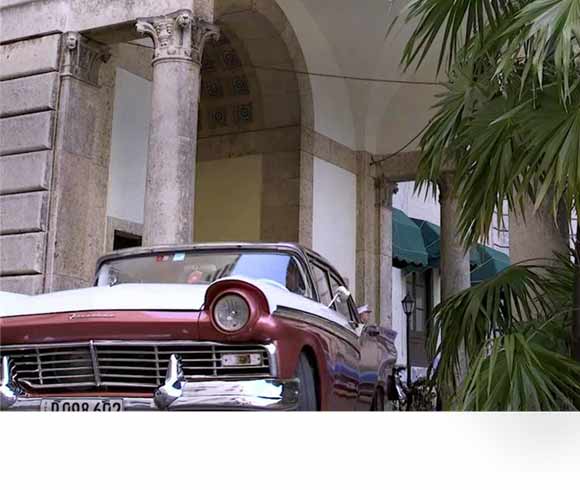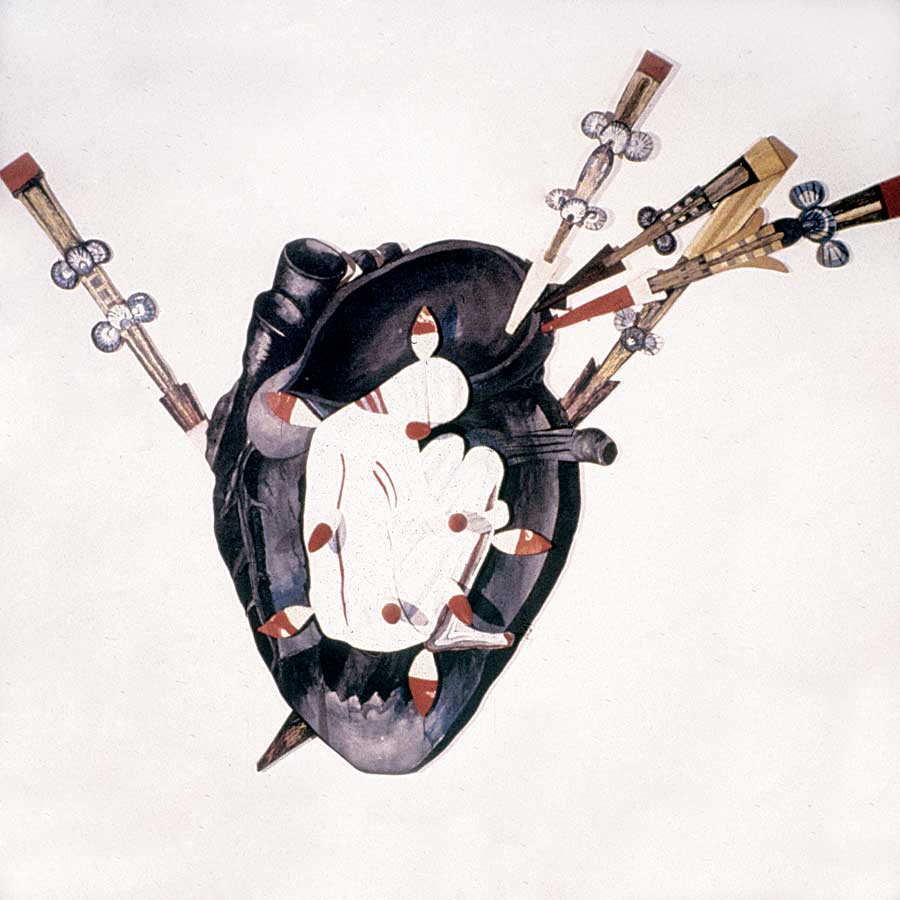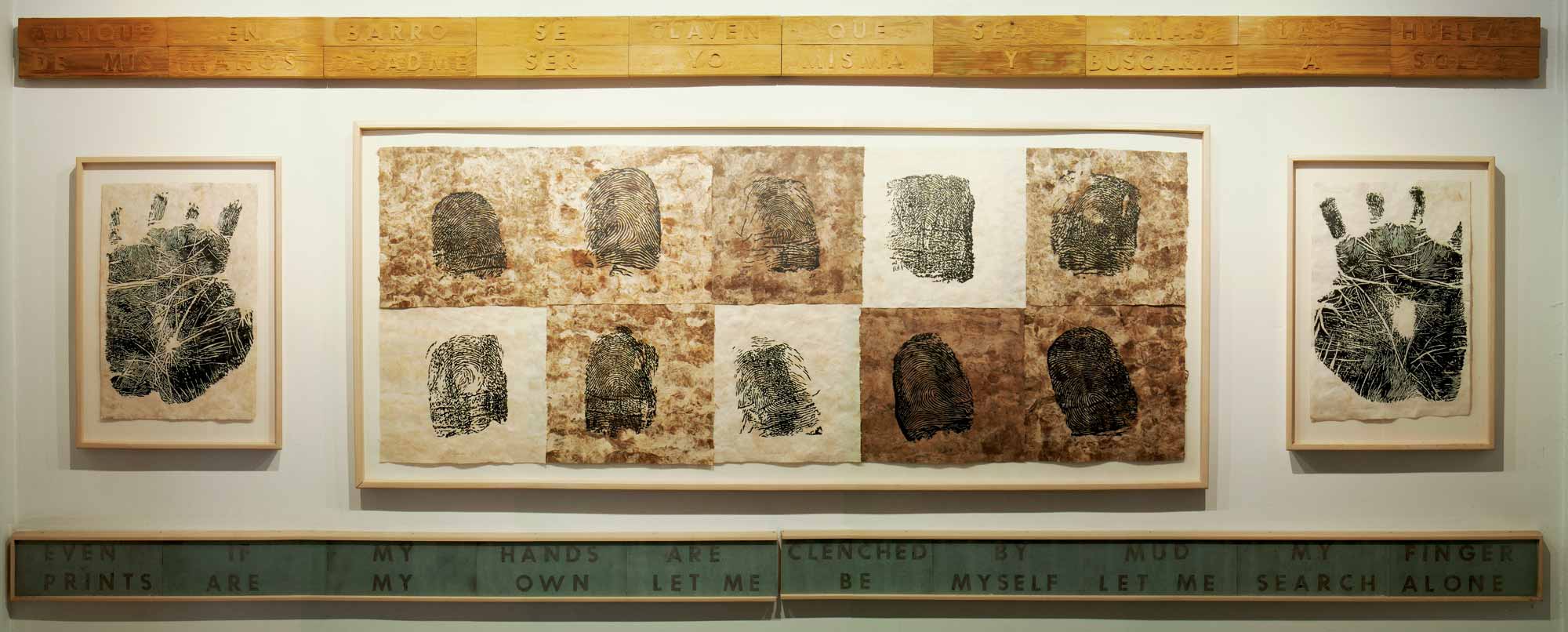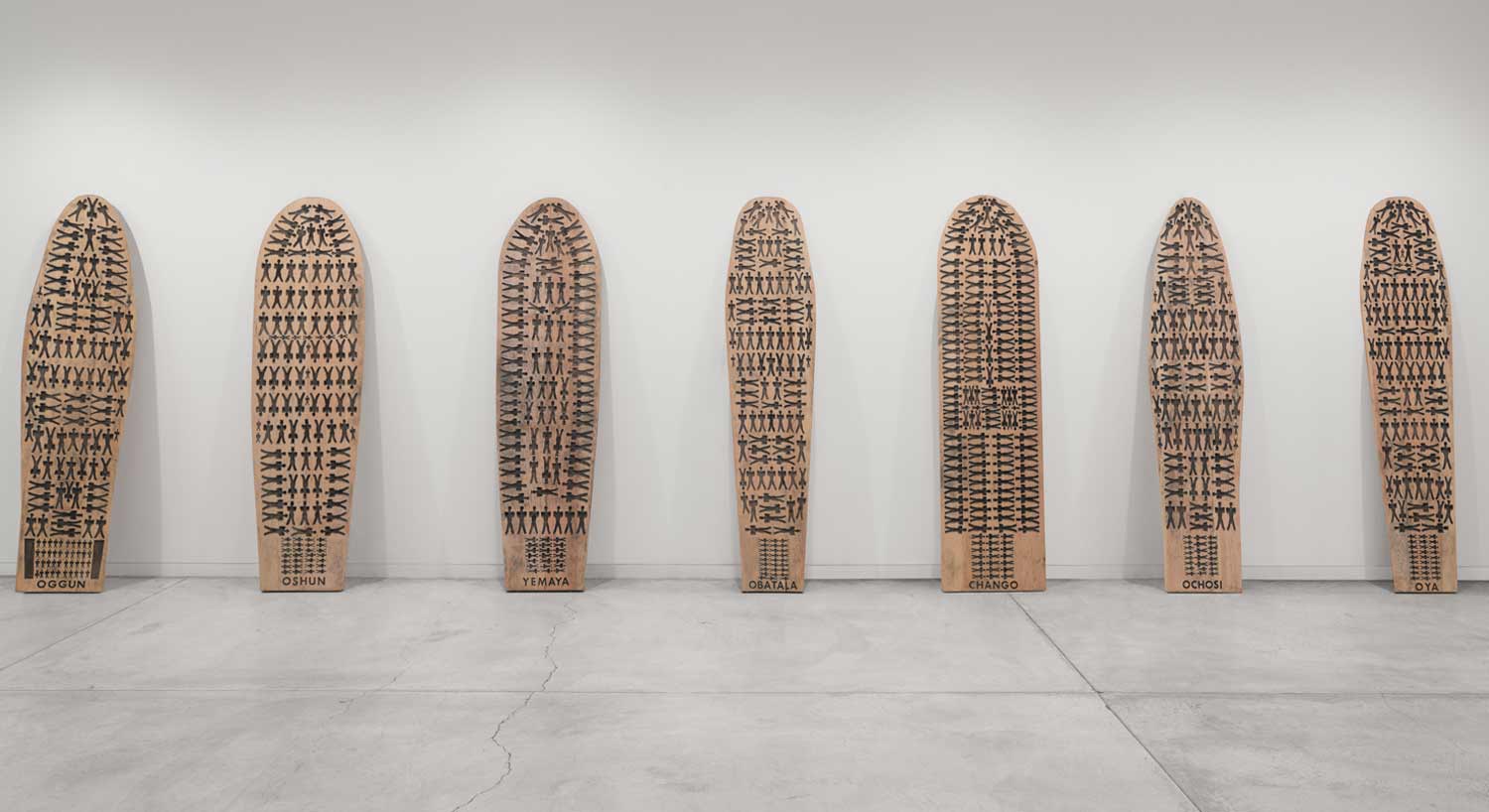One sees in this statement, and the work as a whole, a growing artistic preoccupation with issues of justice and a connection to Africa and ancestral links that would increasingly characterize the artist's work through the 1990s. The piece is a critical one, not only in its content, but also in its artistic form. The Offering of My Own Blood depicts a human figure in the fetal position, encased in what appears to be a large, human heart. The heart is pierced by stylized spears and the figure within it by knives. The work reflects Campos-Pons's continued trajectory away from a traditional painterly approach to one that deploys an array of media and surface treatments. "It's a piece that is almost a relief," she says. "It is a kind of a collage that builds out of the wall, a kind of a tableau vivant . . . there are many, many layers of materials, layers of surface."
The involvement in the Angolan civil war was by no means the only, or even the most significant, issue facing Cuba. In April 1989, Mikhail Gorbachev made a visit to the island and signaled an imminent end to the decades of financial and technical support that the Union of Soviet Socialist Republics (USSR) had provided to the country. The loss of that support would come to have a devastating impact on Cuba, ushering in what became known as Período especial ("Special Period in Time of Peace"), declared by Castro in the summer of 1990. Cuba, Castro proclaimed, would only survive by operating under wartime provisions. As Weiss succinctly describes, "economically, ideologically, logistically, psychologically, Cuba imploded." Almost overnight, the more permissive context of the 1980s that had inspired so much artistic, cultural, and intellectual ferment vanished. For Campos-Pons, this was a crushing blow. Not only did it call into question the potential to pursue her art, but it also left her feeling personally unsafe. In her role as vice president of the council, she had been instructed to censor an exhibition of avant-garde work that included caricatures of Castro and, along with the other leaders of the council, she refused to do so. She recalls, "I was asked to put the show down. They told me it was an order. I told them I was not in the military and that I didn't take orders."
Campos-Pons remembers vividly the exact moment she reached the conclusion that she would need to emigrate. In July 1989, Major General Arnaldo Ochoa, the most popular military commander in Cuba, was arrested with three other officers on charges of drug smuggling. After a brief trial, the four were executed by firing squad. She recalls watching the televised events and her reaction, "I had the feeling that this exhibition, with all its mockery of Castro, was almost like an open door to mockery of Castro, when all the generals who have guns are mocking him for real." In the months that followed, Campos-Pons and fellow artist José Bedia received invitations for the prestigious visual arts fellowship at the Banff Centre for the Arts in Alberta, Canada. In that moment of political strife, she chose to accept the invitation and made plans to depart. Reflecting on that decision, she whispers, "I never came back from Canada. I never came back to Cuba." In leaving, Campos-Pons joined not only Bedia, but also Tomás Sánchez, Ricardo Brey, Rubén Torres Lorca, and almost the entire generation of Cuban visual artists trained during the 1980s in emigrating from the country during these years.
Campos-Pons's experiences as an exchange student and émigré in the late 1980s and early 1990s materially affected the path of her artistic practice on many levels and helped launch the second major phase of her career. The departure from Cuba and move to North America, while welcomed in terms of the freedom and opportunity it offered, also generated an enormous quality of dislocation and disruption for Campos-Pons, engendering what Enwezor aptly refers to as a "double exile." The first exile was the Middle Passage that forcibly relocated Campos-Pons's Yoruba great-grandparents to Cuba to work as slaves on the sugar plantations; the second, the artist's self-initiated exile to Canada and then to the United States, a move that left her unable to return to Cuba for over a decade. The result was an increased focus on a set of issues related to dislocation, personal identity, and the black body, particularly the artist's own body. The enhanced preoccupation with racial justice was further stoked by the growing awareness—made possible by geographic distance—of the level of structural racial bias that simmered below the surface in Cuba, outside the public discourse. At the same time, the exposure to a wide range of new artistic materials and techniques in Boston influenced the compositional and technical aspects of Campos-Pons's practice. Gone was a principal focus on painting, with photography, printmaking, videography, and mixed-media installation–oriented approaches now informing her artistic endeavors in new ways. This shift can be seen best by considering some of her seminal works from this period.
From 1990 to 1991, Campos-Pons found herself subjected to an array of bureaucratic paperwork in order to secure a visa to live in the United States. This process highlighted for her the many issues associated with navigating and crossing borders. Who was permitted to travel and relocate, and why? Who was forbidden the opportunity? Who controlled the borders? Constantly playing in the background was a related set of issues associated with Cuba as an isolated island, in conflict with its neighbor ninety miles across the straits of Florida, even at a time when Soviet-style communism was crumbling. These concerns saw exposure in a mixed-media wall installation called Birth Certificate (1991) (Figure 12). Birth Certificate is comprised of ten dramatically enlarged woodcut images of the artist's fingerprints, framed by two enlarged images of her right and left handprints. As a piece about boundaries and crossings, the hand and fingerprints are themselves circumscribed by borders, specifically a horizontal wooden band running above the framed prints and a band of glass tiles running fence-like beneath. Carved into the wood in Spanish and printed on the glass in English are the words of a poem by Cuban writer and journalist Mirta Aguirre that Campos-Pons recalls committing to memory when she was fourteen years old. The verse as inscribed by the artist reads: "EVEN IF MY HANDS ARE CLENCHED BY MUD MY FINGERPRINTS ARE MY OWN LET ME BE MYSELF LET ME SEARCH ALONE." The artist's choice of glass as the material for the lower band is meant to signify fragility and vulnerability, referencing particularly her insecurity with the English language. Such use of glass, for both aesthetic and metaphorical reasons, can be seen repeatedly in Campos-Pons's work, most notably in Alchemy of the Soul, Elixir for the Spirits.



